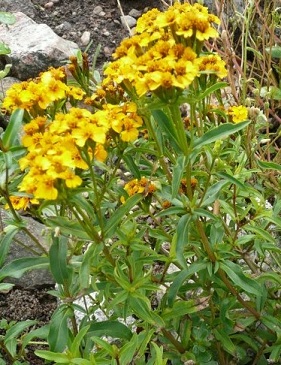by Sandra W. Jefferies © 2001
 Botanical name: Tagetes
lucida
Botanical name: Tagetes
lucida
Common name: Mexican mint marigold, Mexican tarragon, etc.
Family: Asteraceae
When a gardener or want-to-be gardener laments their lack of space, time and energy, yet wants to grow something pretty, I immediately suggest Tagetes lucida. Not only is this tender perennial compact and easy to maintain it also provides flower in fall, enhances many culinary dishes, makes a lovely tea and perfumes and brightens floral arrangements. As if that weren’t enough to entice any gardener, Mexican mint marigold is reputed to attract beneficials to the garden, thereby helping to reduce undesirable pest damage in the garden.
As a member of the Asteraceae family, Tagetes lucida, produces brilliant deep-yellow (lucida), five pedaled blossoms (about 5/8 inch across) that are borne terminally. The erect bushy shrub grows from 2 ½-3 feet here in the low desert and a little less at higher elevations. The glabrous, sessile leaves are linear (~ 1 ½ inches long), serrulate (fine toothed), and contain essential oils quite similar to the much loved French tarragon. Grow this tender perennial in well-drained soil and full sun, although here in USDA zone 9- Sunset zone 13, it will benefit if sheltered from the late afternoon sun, especially in the summer months. Regular watering is a must during the hot season, but most of the year for an established plant a deep watering every 5-7 seven days will suffice (depending on your soil condition). This plant is hearty to 20 degrees F., so at the higher elevations one might consider potting-up the plant for the winter and keeping it in a sheltered, sunny location.
Even though sources say it is a heat-loving plant, I have found reflective and radiant heat to be a problem. In certain locations, such as next to a sidewalk, driveway, or block wall, Tagetes lucida will burn a bit. Don’t be fooled that the plant has died, just water well and after the temperature is back down to a reasonable 100 degrees F, trim the shrub back by a third. If you do this too late in the season, the blooming period will be delayed, but again don’t worry. As mentioned earlier Tagetes lucida is an easy plant to maintain because it generally only requires a shearing back once a year in spring (if growing as a perennial, and why not).
Layering, division or stem cutting in the early spring are the preferred methods of propagation in the low desert, although it can be grown from seed as well. At higher elevations and in shorter season zones, propagation is best practiced in early summer. If starting plants from seed it is best to start the seeds indoors 6-8 weeks prior to planting in the garden after the last expected frost.
As mentioned earlier, culinary uses for Tagetes lucida, are numerous and varied. Very simply a tea can be made using the anise-like leaves or sprigs. Use the leaves in any dish calling for French tarragon, but be a little judicious as the compounds are more pronounced in Tagetes lucida. Put the whole leaves in a bouquet garni or vinegar, use chopped leaves to make herb butter or cheese spread, and don’t forget to use in fish and egg dishes (especially in a French style omelet).
Use Tagetes lucida as an ornamental specimen plant or as part of a border or foundation planting interspersed with low growing thymes or lobelias for contrast. Grow about a foot apart if growing multiples and place where one can brush up against the plant so the fragrant oils waft through the garden. This plant makes for a great pet plant, as it is irresistible to walk past without brushing your hand over the shrubby beauty and then inhaling the fragrance left on your palms. Breathe deeply and enjoy.
Sources: If you can’t find Tagetes lucida locally
(it is sometimes difficult), a good source is Mountain Valley Growers in
Squaw Valley, CA.
Sandra W. Jefferies is a garden writer with a background in horticulture. She is also a Master Gardener and currently serve as VP of the Arizona Herb Association.
|
Desert Tropicals Home Page List of All the Plants /b> Desert-Tropicals is dedicated to provide gardening advice, gardening ideas, and information about flower of all kind for landscape and collections.We try to check carefully the identification of the plants on the illustrations as well as the other information from the page, but occasionally errors do occur. if you notice anything that needs to be changed please contact us.Thanks. © 1998-2020 Philippe Faucon, All Rights Reserved. |